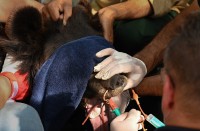LOS ANGELES, California (Reuters) — Flying a single autonomous drone already has its challenges. Now multiply that by 25. That’s what scientists at the University of Southern California (USC) are doing: creating ‘flocks’ of coordinated drones capable of intricate, synchronized maneuvers.
Their aerial performances are the result of complicated coding and algorithms – which ensure that each drone maintains its own path, avoiding the airspace of its neighbors. The drones are monitored by a series of cameras which track and coordinate their every move, relaying information between the robots and a master computer.
“Coordinating teams of robots is an extremely difficult problem,” said USC computer science professor Nora Ayanian. “You have to try to figure out in general if you’re trying to solve a complicated task, you have to try to figure out you know what is that task, how do you define that task for the robots, how do you break that up into pieces so that each robot can do each of those different pieces, and then how do you ensure that each of the robots actually does the job so that the entire team can can be successful. And so what we’re watching here is a very kind of successful demonstration of teams of robots coordinating to do different tasks.”
Those different tasks could range from things like search and rescue, to coastal and border surveillance, to wildfire monitoring.
“You know in general the idea is for teams of robots to do things that are challenging for humans to do or even impossible. So going into collapsed buildings, an aerial vehicle can fly through gaps whereas a vehicle that you know might be on the ground might have difficulty going over some kind of rubble. And so I think that…for teams of robots, it makes sense to do these kinds of difficult tasks that we don’t want humans to do.”
Ayanian and her team are working to create a simple controller, say via a computer or tablet interface, that would one day allow someone to easily control drones using an established set of codes – turning what are now aerial stunts into real life applications.







